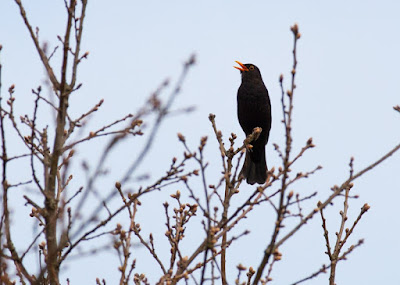 |
| Goldfinch (c) Bark |
Spring migration is well and truly underway despite the unseasonably cold last few weeks, that have produced frosty nights and even one morning of snow. One wonders what the newly arrived insectivorous birds are finding to eat.
 |
| Chiffy (c) Bark |
Grasshopper Warblers were heard reeling on Tuesday morning for the first time this year. They were in the car-park Field and also out on Greenaways. Only Lesser Whitethroat and Garden Warbler have still to arrive, of our suite of regular breeding Warblers.
 |
| Singing Blackcap (c) Bark |
There has been migrating Yellow Wagtails feeding in the reedbed and it appears also roosting there . The reeds are very broken down and flattened this year, due to the winter rains and wind and the sheer weight of Starlings resting on them all winter. There must also have been a welcome hatch of small insects emerging amid this more sheltered habitat. They have also been seen feeding amongst the sheep at Noke.
 |
| Swallow at Noke (c) Bark |
Cuckoo arrived last weekend and Whinchat just yesterday (14th April). Big Otmoor hosted an early Whimbrel, a species that visits annually, but more often in early May than mid-April.
Whimbrel courtesy of Isaac West.
We found a Bar-tailed Godwit last weekend also out on Big Otmoor, a bird we failed to record at all last year. This area is looking very attractive to passage waders at present and will do so until the sedges grow up and the waters recede. Snipe are starting to drum over Greenaway’s and Big Otmoor and this activity will only increase as spring progresses.
 |
| Bar-tailed Godwit courtesy of Isaac West. |
 |
| Singing Blackbird and Wren (c) Tom N-L |
Residents and summer visitors are wasting no time in establishing territories and in finding mates , the volume of song and calling is going up all the time. We watched a pair of Goldfinches courting beside the hide.
 |
| Courting Goldfinches (c) Bark |
Not just making their familiar twittering calls but they were flashing wings, spreading tails and almost seeming to pirouette at the top of the dead tree in some sort of courtship dance. It was a behaviour I had not noticed before.
 |
| Confiding Cetti's (c) Bark |
There are three booming male Bitterns, one at Noke, another on the reedbed and the third out in the middle of Greenaways where we have often spotted them in the open. Two birds were seen together on Wednesday and so we can be certain that we have at least one female. The male in the photograph can be identified by its distinctly blue cere.
 |
| Distant Bitterns on Greenaways (c) Tom N-L |
There have been regular sightings of Wheatears at Noke in the usual places beside the farm and along the fences.
 |
| Noke Wheatear in the rain. (c) Bark |
Swallows have returned once again to the barns. There is a pair of Green Woodpeckers that are spending a lot of time feeding out in the sheep fields. There were over eighty Fieldfares out in the fields to the south of the Closes along with a few Redwings and a pair of Mistle Thrushes, one of which was singing loudly from the top of a bare tree.
 |
| Mistle Thrush (c) Bark |
Across many of the fields Lapwings are sitting on nests and Redshanks are not far behind them in the breeding process, their calling, chasing and courtship seems to be everywhere.
 |
| Redshank (c) Bark |
At the northern lagoon, a pair of Great Crested Grebes has arrived and may well be constructing a nest in the reeds to the left of the second screen.
 |
| Heron and Great Crested Grebe at the second screen.(c) Bark |
Herons are coming and going bringing food to their chicks in the reedbed, where we think there may be four or five nests.
 |
| Peacock and Bullfinch (c) Bark |
It is at this time of the year that one realises just how much Blackthorn there is across the moor as the hedgerows become blanketed with frothy white blossom. Birds sit amongst it and sing and insects feed on the nectar and pollen.
 |
| Bee-fly and Cootlings by the Hide (c) Bark |





No comments:
Post a Comment